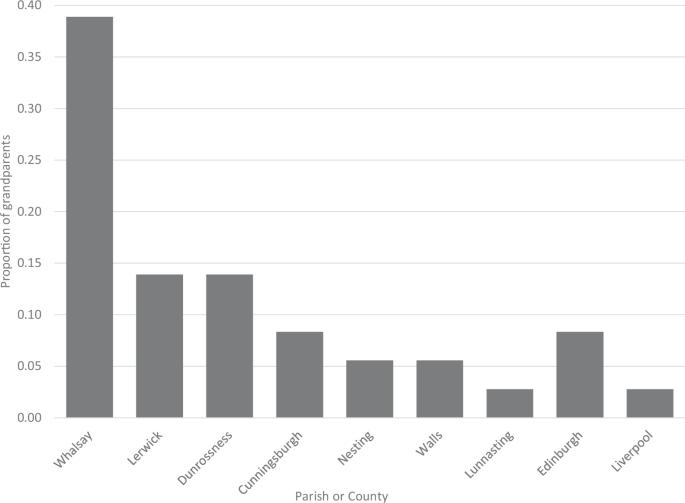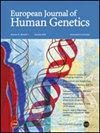在苏格兰的奥克尼岛和设得兰群岛,两种始祖变异占致病性 BRCA 等位基因的 90% 以上。
IF 4.6
2区 生物学
Q2 BIOCHEMISTRY & MOLECULAR BIOLOGY
引用次数: 0
摘要
对于奥克尼和设得兰(位于英国苏格兰)北部群岛及其散居地与世隔绝人群的乳腺癌和卵巢癌风险评估来说,量化基因漂移的 BRCA1 和 BRCA2 致病变体非常重要。这些基因中的两个可操作变体的频率远远高于英国的世界性人群。在这里,我们报告了在设得兰岛的乳腺癌和卵巢癌家族中发现的 BRCA2 剪接受体变异 c.517-2A>G。我们在一个基于设得兰群岛血统的人群研究队列(VIKING I)中调查了该变异的频率和来源。该变异在确诊病例中与女性乳腺癌和卵巢癌发生分离,并被归类为致病性。来自 2108 名有三个或三个以上设得兰祖父母的 VIKING I 参与者的外显子组序列数据被用来估计 c.517-2A>G 在设得兰人中的流行率。九名 VIKING I 研究志愿者在一个共享单倍型上携带该变异体(携带者频率为 0.4%)。这一频率比英国生物库中的频率高出约 130 倍,而英国生物库中的一小部分携带者具有不同的单倍型。出生、婚姻和死亡记录表明,VIKING I 携带者与设得兰岛 Whalsay 岛的创始人有家谱联系,这与我们对奥克尼岛 Westray 的 BRCA1 创始人变体 c.5207T>C 的观察结果类似。总的来说,这两个漂移变异体占北部群岛外显子中致病性 BRCA 变异携带者的 93.5%。因此,我们提供了科学证据,证明有机会对奥克尼和设得兰血统的人,尤其是有 Westray 或 Whalsay 血统的妇女进行每种漂移致病变体的筛查。本文章由计算机程序翻译,如有差异,请以英文原文为准。

Two founder variants account for over 90% of pathogenic BRCA alleles in the Orkney and Shetland Isles in Scotland
For breast and ovarian cancer risk assessment in the isolated populations of the Northern Isles of Orkney and Shetland (in Scotland, UK) and their diasporas, quantifying genetically drifted BRCA1 and BRCA2 pathogenic variants is important. Two actionable variants in these genes have reached much higher frequencies than in cosmopolitan UK populations. Here, we report a BRCA2 splice acceptor variant, c.517-2A>G, found in breast and ovarian cancer families from Shetland. We investigated the frequency and origin of this variant in a population-based research cohort of people of Shetland ancestry, VIKING I. The variant segregates with female breast and ovarian cancer in diagnosed cases and is classified as pathogenic. Exome sequence data from 2108 VIKING I participants with three or more Shetlandic grandparents was used to estimate the population prevalence of c.517-2A>G in Shetlanders. Nine VIKING I research volunteers carry this variant, on a shared haplotype (carrier frequency 0.4%). This frequency is ~130-fold higher than in UK Biobank, where the small group of carriers has a different haplotype. Records of birth, marriage and death indicate genealogical linkage of VIKING I carriers to a founder from the Isle of Whalsay, Shetland, similar to our observations for the BRCA1 founder variant c.5207T>C from Westray, Orkney. In total, 93.5% of pathogenic BRCA variant carriers in Northern Isles exomes are accounted for by these two drifted variants. We thus provide the scientific evidence of an opportunity for screening people of Orcadian and Shetlandic origins for each drifted pathogenic variant, particularly women with Westray or Whalsay ancestry.
求助全文
通过发布文献求助,成功后即可免费获取论文全文。
去求助
来源期刊

European Journal of Human Genetics
生物-生化与分子生物学
CiteScore
9.90
自引率
5.80%
发文量
216
审稿时长
2 months
期刊介绍:
The European Journal of Human Genetics is the official journal of the European Society of Human Genetics, publishing high-quality, original research papers, short reports and reviews in the rapidly expanding field of human genetics and genomics. It covers molecular, clinical and cytogenetics, interfacing between advanced biomedical research and the clinician, and bridging the great diversity of facilities, resources and viewpoints in the genetics community.
Key areas include:
-Monogenic and multifactorial disorders
-Development and malformation
-Hereditary cancer
-Medical Genomics
-Gene mapping and functional studies
-Genotype-phenotype correlations
-Genetic variation and genome diversity
-Statistical and computational genetics
-Bioinformatics
-Advances in diagnostics
-Therapy and prevention
-Animal models
-Genetic services
-Community genetics
 求助内容:
求助内容: 应助结果提醒方式:
应助结果提醒方式:


